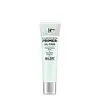What's inside
What's inside
 Key Ingredients
Key Ingredients

 Benefits
Benefits

 Concerns
Concerns

 Ingredients Side-by-side
Ingredients Side-by-side

Water
Skin ConditioningCyclopentasiloxane
EmollientDimethicone
EmollientGlycerin
HumectantHydrogenated Polyisobutene
EmollientOzokerite
Emulsion StabilisingHdi/Trimethylol Hexyllactone Crosspolymer
Butylene Glycol
HumectantPolymethylsilsesquioxane
Lauryl PEG-10 Tris(Trimethylsiloxy)Silylethyl Dimethicone
EmulsifyingTrimethylsiloxysilicate
EmollientSodium Chloride
MaskingDimethicone/PEG-10/15 Crosspolymer
Silica
AbrasiveRosa Centifolia Flower Oil
MaskingEpilobium Fleischeri Extract
Skin ConditioningPaeonia Lactiflora Root Extract
Skin ConditioningPrunus Persica Kernel Extract
MoisturisingPerilla Ocymoides Leaf Extract
TonicDimethicone Crosspolymer
Emulsion StabilisingCaprylyl Glycol
EmollientGlyceryl Caprylate
EmollientTocopheryl Acetate
AntioxidantDisodium EDTA
Ethylhexylglycerin
Skin ConditioningCI 77891
Cosmetic ColorantCI 77491
Cosmetic ColorantTriethoxycaprylylsilane
Citric Acid
BufferingPotassium Sorbate
PreservativeWater, Cyclopentasiloxane, Dimethicone, Glycerin, Hydrogenated Polyisobutene, Ozokerite, Hdi/Trimethylol Hexyllactone Crosspolymer, Butylene Glycol, Polymethylsilsesquioxane, Lauryl PEG-10 Tris(Trimethylsiloxy)Silylethyl Dimethicone, Trimethylsiloxysilicate, Sodium Chloride, Dimethicone/PEG-10/15 Crosspolymer, Silica, Rosa Centifolia Flower Oil, Epilobium Fleischeri Extract, Paeonia Lactiflora Root Extract, Prunus Persica Kernel Extract, Perilla Ocymoides Leaf Extract, Dimethicone Crosspolymer, Caprylyl Glycol, Glyceryl Caprylate, Tocopheryl Acetate, Disodium EDTA, Ethylhexylglycerin, CI 77891, CI 77491, Triethoxycaprylylsilane, Citric Acid, Potassium Sorbate
Water
Skin ConditioningGlycerin
HumectantAlcohol Denat.
AntimicrobialDimethicone
EmollientAmmonium Polyacryloyldimethyl Taurate
Emulsion StabilisingSilica
AbrasivePhenoxyethanol
PreservativeCapryloyl Glycine
CleansingCetyl Dimethicone
EmollientCarbomer
Emulsion StabilisingSilica Silylate
EmollientBoron Nitride
AbsorbentCaprylyl Glycol
EmollientBis-PEG-18 Methyl Ether Dimethyl Silane
EmollientButylene Glycol
HumectantDimethicone/PEG-10/15 Crosspolymer
Cetearyl Alcohol
EmollientSodium Hydroxide
BufferingTrisodium Ethylenediamine Disuccinate
Totarol
AntioxidantAloe Barbadensis Leaf Juice Powder
Skin ConditioningGlyceryl Acrylate/Acrylic Acid Copolymer
HumectantCetearyl Glucoside
EmulsifyingDipropylene Glycol
HumectantZingiber Officinale Root Extract
MaskingSanguisorba Officinalis Root Extract
CleansingCinnamomum Cassia Bark Extract
MaskingSodium Citrate
BufferingCI 14700
Cosmetic ColorantTocopherol
AntioxidantWater, Glycerin, Alcohol Denat., Dimethicone, Ammonium Polyacryloyldimethyl Taurate, Silica, Phenoxyethanol, Capryloyl Glycine, Cetyl Dimethicone, Carbomer, Silica Silylate, Boron Nitride, Caprylyl Glycol, Bis-PEG-18 Methyl Ether Dimethyl Silane, Butylene Glycol, Dimethicone/PEG-10/15 Crosspolymer, Cetearyl Alcohol, Sodium Hydroxide, Trisodium Ethylenediamine Disuccinate, Totarol, Aloe Barbadensis Leaf Juice Powder, Glyceryl Acrylate/Acrylic Acid Copolymer, Cetearyl Glucoside, Dipropylene Glycol, Zingiber Officinale Root Extract, Sanguisorba Officinalis Root Extract, Cinnamomum Cassia Bark Extract, Sodium Citrate, CI 14700, Tocopherol
Ingredients Explained
These ingredients are found in both products.
Ingredients higher up in an ingredient list are typically present in a larger amount.
Butylene Glycol (or BG) is used within cosmetic products for a few different reasons:
Overall, Butylene Glycol is a safe and well-rounded ingredient that works well with other ingredients.
Though this ingredient works well with most skin types, some people with sensitive skin may experience a reaction such as allergic rashes, closed comedones, or itchiness.
Learn more about Butylene GlycolCaprylyl Glycol is a humectant and emollient, meaning it attracts and preserves moisture.
It is a common ingredient in many products, especially those designed to hydrate skin. The primary benefits are retaining moisture, skin softening, and promoting a healthy skin barrier.
Though Caprylyl Glycol is an alcohol derived from fatty acids, it is not the kind that can dry out skin.
This ingredient is also used as a preservative to extend the life of products. It has slight antimicrobial properties.
Learn more about Caprylyl GlycolDimethicone is a type of synthetic silicone created from natural materials such as quartz.
What it does:
Dimethicone comes in different viscosities:
Depending on the viscosity, dimethicone has different properties.
Ingredients lists don't always show which type is used, so we recommend reaching out to the brand if you have questions about the viscosity.
This ingredient is unlikely to cause irritation because it does not get absorbed into skin. However, people with silicone allergies should be careful about using this ingredient.
Note: Dimethicone may contribute to pilling. This is because it is not oil or water soluble, so pilling may occur when layered with products. When mixed with heavy oils in a formula, the outcome is also quite greasy.
Learn more about DimethiconeDimethicone/PEG-10/15 Crosspolymer is a type of silicone.
Glycerin is already naturally found in your skin. It helps moisturize and protect your skin.
A study from 2016 found glycerin to be more effective as a humectant than AHAs and hyaluronic acid.
As a humectant, it helps the skin stay hydrated by pulling moisture to your skin. The low molecular weight of glycerin allows it to pull moisture into the deeper layers of your skin.
Hydrated skin improves your skin barrier; Your skin barrier helps protect against irritants and bacteria.
Glycerin has also been found to have antimicrobial and antiviral properties. Due to these properties, glycerin is often used in wound and burn treatments.
In cosmetics, glycerin is usually derived from plants such as soybean or palm. However, it can also be sourced from animals, such as tallow or animal fat.
This ingredient is organic, colorless, odorless, and non-toxic.
Glycerin is the name for this ingredient in American English. British English uses Glycerol/Glycerine.
Learn more about GlycerinSilica, also known as silicon dioxide, is a naturally occurring mineral. It is used as a fine, spherical, and porous powder in cosmetics.
Though it has exfoliant properties, the function of silica varies depending on the product.
The unique structure of silica enhances the spreadability and adds smoothness, making it a great texture enhancer.
It is also used as an active carrier, emulsifier, and mattifier due to its ability to absorb excess oil.
In some products, tiny microneedles called spicules are made from silica or hydrolyzed sponge. When you rub them in, they lightly polish away dead skin layers and enhance the penetration of active ingredients.
Learn more about SilicaWater. It's the most common cosmetic ingredient of all. You'll usually see it at the top of ingredient lists, meaning that it makes up the largest part of the product.
So why is it so popular? Water most often acts as a solvent - this means that it helps dissolve other ingredients into the formulation.
You'll also recognize water as that liquid we all need to stay alive. If you see this, drink a glass of water. Stay hydrated!
Learn more about Water